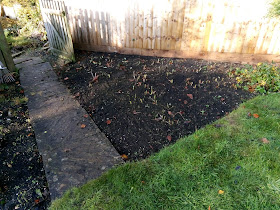The Asparagus fronds are finally turning yellow so it's time to cut them back for the winter.
This is a job that rates as "easy peasy" and is very satisfying to do, especially on a cold grey morning when everything looks a bit sad and tatty...
First job, then: cut down the top growth.
Out with the secateurs, and off we go: cut each stem low down, just an inch or so above the soil.
Here you can see that I've made a start, there's already a barrow-full of cuttings.
In my case I also had to remove the supporting strings around the foliage: this particular Asparagus bed is next to a path, and the foliage tends to flop, so I put some hooks in the fence behind, and run lines of string around the top growth to keep it well back off the path.
As these are all male plants, they don't have any seeds, so it's safe to put all the material straight onto the compost heap.
Cutting off the tops reveals the horrors of the weeds underneath - during the late summer, it's impossible to weed between the close-packed stems, so I just leave it until autumn and deal with it all in one go.
So having removed the tops, I can then step into the bed to get all the weeds out. Now you can see why I leave an inch or so of the stems - so that I can see where the crowns are. This prevents me from damaging them by accidentally weeding too deeply or energetically around the crowns.
They are mostly annual weeds, but in this garden we also have bit of a problem with bindweed and ivy creeping over from next door.
The ivy is simple to deal with: any that comes over the top of the fence gets firmly pushed back onto their side, and any that tries to creep through the slats of the fence is gently pushed back through the slats, using my faithful daisy grubber. It's important to stop ivy trying to sneak through fences, as once it gets through, the stems will fatten and eventually will break the fence. But if you catch it while it's young, it's easy to just poke the new stems back to "their" side of the fence.
The bindweed, however, is a bit more of a problem, so I deal with it here by keeping a strip about 2' wide (60cms) bare at the base of the fence, to give me access during spring and early summer.
Here's what it looks like in June, when we have stopped cropping the Asparagus and are allowing it to grow out.
You can see my trampled area where I walk along, digging out or spraying any bindweed that I can find.
It's almost impossible to get rid of bindweed creeping through from next door: all you can do is keep on top of it, by removing or spraying every tiny shoot that dares to show itself.
Here, it's a particular nuisance because I can't dig it out if it gets into the Asparagus crowns, so it's essential to catch it while it is small, and this means I have to check every week.
If I'd been there when the neighbour replaced their fence, I would have asked them to add a couple of extra planks/gravel boards at the base of the fence, sinking them down about a foot (30cm) below ground level. This would have prevented their bindweed sneaking into "our" garden. Too late now! If it were my own garden, I would just do it: I would dig a trench on my side of the fence, at least a foot deep, and fix boards across, making sure that they either overlapped, or were fitted very close together, with no gaps.
Heyho!
Back to the plot: out come the annual weeds, and they all go on the compost heap: out comes a big bucketful of bindweed roots and shoots, and they go on the rubbish pile. If you don't have a bonfire pile, they can go into your council green waste wheelie bin: it's ok to put them in there, as they get processed at high temperature which kills them. But never put them onto your compost heap, otherwise you'll end up with a compost heap full of bindweed....
And here we are, job done: weeds out, top growth cut back, all nice and clear ready for mulching.
Then I just leave it alone until next year, when we start to crop the asparagus again.
Easy peasy!
Did you enjoy this article? Did you find it useful? Would you like me to answer your own, personal, gardening question? Become a Patron - just click here - and support me! Or use the Donate button for a one-off donation. If just 10% of my visitors gave me a pound a month, I'd be able to spend a lot more time answering all the questions!!



No comments:
Post a Comment
Comments take around 2 days to appear: please be patient. Excessive SPAM has forced me to restrict comments to just Members: if you have a question, you can become a Member: or you can hop over to Patreon and join me there: or you can email me direct - my email address is in the right-hand pane. Sorry about this, but honestly, the spam! I'm drowning in it!!
Note: only a member of this blog may post a comment.